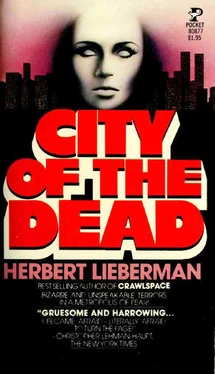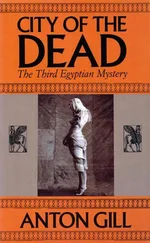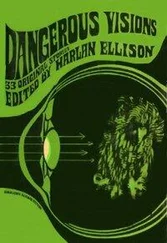Working steadily for the past four hours, all by himself in the solitude of the abandoned autopsy room, no sound within the place but the dripping of a water tap behind him, Konig has managed to assign all the remaining limbs to either one torso or the other. Both now have arms and legs.
Working that afternoon with both sets of arms, he has found that the heads of the shorter humeri were too small to fit the shoulder joints of the reconstructed trunk, just as the heads of the shorter femora were found to be too small to fit the hip joints.
But when he attached the longer set of humeri to the same trunk, not only did the sockets fit neatly, but with the addition of the longer pair of forearms, the arms appeared in correct proportion to the length of the trunk. The tips of the fingers, allowing for the removal of the terminal segments, were suddenly in correct relation to the thighs. But when the shorter pair of humeri and forearms were attached to that same pair of shoulder joints, the fingertips came just below the level of the hip joints, an impossible proportion for a normal body.
So Konig’s hypothetical case based upon only two bodies is building slowly toward an incontestable fact. He sits silently now before the two broken, battered things, which, albeit headless, nevertheless have begun to bear the unmistakable configuration of mortal man. Though still unidentified, still mysterious, unknown figures, it is now at last possible to see the lineaments of humanity in the reconstituted parts. Both bodies have undergone partial resurrection, and Paul Konig, like an old, demented dollmaker, sits before his half-creations now, still baffled by the numerous unassignable soft parts, odds and ends, human debris scattered all about him. He gazes down upon these half-creatures, pondering their curiously peaceful repose, trying to decipher the riddle contained in a handful of bones.
Number 1 and Number 2—the short and the long—already he knows a great deal about each. Even as he gazes over them, he feels a growing affection, a growing intimacy, a physician’s intimacy, as their various parts merge slowly into anthropomorphic form. They’re now a bit like old friends. Working on Number 1’s badly mutilated feet, which had been viciously slashed across the arches and had had several toes amputated in an attempt obviously to erase some identifiable feature, Konig has found a curious metatarsal deformity, an unnatural curving outward of the big toe, hinting at a painful foot problem. Then, too, Number 2’s back in the area of the fourth and fifth lumbar vertebrae reveals definite disc displacement as well as a pelvic asymmetry, as if he’d walked for many years with a compensatory gait in order to alleviate severe sacral pain.
It was curious the way the heads arrived, just as Konig was going to get up and go home. Not that he wanted to go home. He dreaded the prospect, but there seemed nothing left to do, and his leg had started shrieking again. Then they came, in a cheap vinyl suitcase plastered over with a lot of paper college pennants and swabbed with mud. They’re carried in by a young cop, looking frightened and a little queasy. He doesn’t know exactly what it is he is carrying, only that it’s “something” and that he wants to get shut of it as quickly as possible.
Konig, however, knows what it is, knows instinctively the moment he grasps the muddy handle and slings the case onto a table. The heft of the thing and the dull, sickening thud of the stuff inside bumping together tell him all he needs to know.
His fingers tremble as he fumbles with the clasps, and raising the lid of the case, he feels a rising sense of excitement, an inner gush, rather like the confluence of innumerable tiny streams suddenly merging into a single roaring torrent.
All he sees at first is a lot of old crumpled newspaper, as muddy as the case itself and spattered with innumerable tiny spots of red. The paper is evidently there as a kind of cushion for the contents, rather like the way you pack fragile porcelain or glass in excelsior. On top of all that newspaper lies a small white piece of bond, torn from a memo pad, upon which is indited in a large, hectic scrawl:
Here are your heads.
I hope you’re happy.
Flynn
P.S.
You were right, goddamn you.
They were under the floorboards.
In the next moment, his hands are pushing through the crumpled newssheet, thrusting aside paper with tiny bits of adherent hair, shards of clotted gore. Then suddenly, there they are.
Konig is not a squeamish man. In nearly forty years of service at the Medical Examiner’s Office, he has seen some pretty grisly sights. For the most part, such things have left him unfazed, or at least inured. But the condition of these two heads, or rather what remains of them, has shown him a wholly new, undreamed of dimension of man’s capacity for visiting havoc on his fellow man.
Both heads have been drastically mutilated with the deliberate intention of making the possibility of identification extremely remote. Just as the fingers and toes on each corpse had been either mutilated or hacked off, to remove all identification marks, so, too, in the case of the heads, the features of each had been obliterated—eyes, ears, nose, lips, almost all flesh cut away from the face, and nearly all of the hair and scalp removed—violently excised. The skin tissue had been peeled off like a glove so as to reveal the skull beneath; also, many of the teeth in each head had been extracted in order to make identification by means of dental charts very difficult. The less mutilated of the two heads is clearly that of a man. The other—a smaller, somewhat slighter skull—is of equivocal sex. It might well be that of a woman.
The first head, the more mutilated of the two, had been severed from the neck immediately below the level of the chin. Not only have all the visible facial features been removed, but nearly the whole of the skin of the head and face as well. Two small portions of scalp remain, one over the lower quadrant of the right side and the other just behind the left ear opening. The lips have been entirely cut away; the two upper central incisor teeth have been drawn and the tongue, its tip cut off, protrudes slightly in the gap.
The second head had been severed from the neck at a level slightly lower than that of the first. A huge chunk of scalp is missing from the right side of the head and most of the skin and underlying tissue of the forehead and face have been removed. Flaps of skin still adhere to each cheek, trailing down to the chin and below it. Both lips have been almost completely cut off and nearly all teeth have been drawn. Between the jaws protrudes a swollen tongue.
Just before the stump of the left ear there is a tuft of dark hair. The portion of the scalp remaining on the left side of the head bears a curious Y-shaped laceration covered with dark hair. It is clear to Konig that the wound was caused by forcible contact with a blunt instrument. He cannot say for certain whether or not the wound was produced before or after death.
Konig, examining the first skull under a magnifying glass, quickly locates two fractures. The first is a depressed fracture measuring three-quarters of an inch by a half inch, shelving from behind forward. The injury has broken the outer table of bone, causing a slight depression on the inner table. Slightly behind this fracture, and to the left of the midline, Konig pinpoints the second fracture, affecting the outer table only. This measures a quarter inch in diameter. Once again Konig is uncertain whether the fractures have been inflicted before or after death. But he is certain that they resulted from two separate blows with a blunt instrument. Undoubtedly the same instrument that had produced the Y-shaped laceration on the second head. Had they been inflicted during life, the blows would probably have been sufficient to produce unconsciousness, but they do not appear to have been sufficiently violent to have caused death. He must look elsewhere now for the cause of death.
Читать дальше












